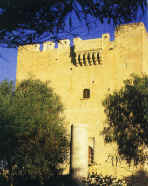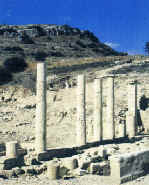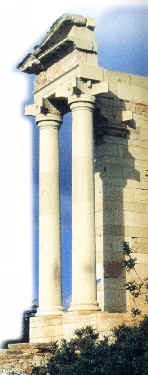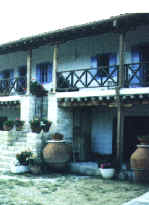|
|
Successor to two city-kingdoms and host to a Royal Wedding in the middle Ages, contemporary Lemesos stretches along South coast.
Proud of the spontaneous hospitality of its people, its archaeological sites, its mediaeval castles and its merry Carnival and Wine festivals, Lemesos is the island's most important tourist and wine industry center.
Hotels, restaurants and nightspots abound along the beach whilst close by lie pine-clad southern slopes of Troodos, with picturesque wine producing villages, idyllic mountain resorts and picturesque Pitsylia area.

Kollosi, Medieval Castle
Places of Interest:
Lemesos Mediaeval Fort: Cyprus Mediaeval Museum
Close to the old port, Tel: (05) 33 04 19
I is built in 14th century on the site of an earlier Byzantine castle and houses Cyprus Mediaeval Museum. It was here that, according to tradition, Richard the Lionheart married Berengaria of Navarre and crowned her Queen of England in 1191.
Lemesos District Archaeological Museum
Vyronos 5, near the Public Gardens, Tel: (05) 33 01 57
Interesting collection of antiquities found in Lemesos area, from Neolithic Age to Roman Period.
Municipal Folk Art Museum
Agiou Andreou 253, Tel: (05) 36 23 03
A beautiful collection of Cyprus Folk Art of 19th and early 20th century, is exhibited in a restored old house.
Lemesos Municipal Art Gallery
28 Oktovriou 103, Tel: (05) 34 32 12 and 34 33 83
Art gallery houses a representative collection of paintings of well-known contemporary Cypriot artists.

Ancient Amathous
Out of City, Area 1:
Kolossi Castle
14 km West of Lemesos, on the road to Pafos
A fine example of military architecture originally constructed in 13th century and subsequently rebuilt in its present form in the middle of 15th century. After the fall of Acre in 1291, it served as Grand Commandery of the Knights of the Order of St. John of Jerusalem. In 14th century, it came for a few years under the domain of Knights Templar. Nearby are the ruins of a sugar mill dating to 14th century.
Kourion Museum
14 km West of Lemesos, 4 km before Kourion site, at Episkopi village, Tel: (05) 23 24 53
Collection of finds from nearby archaeological sites, exhibited in a beautiful old house.
Kourion
19 km West of Lemesos, on the road to Pafos
An important ancient city-kingdom and one of the most spectacular archaeological sites on the island, where excavations still bring new treasures to light. The magnificent Graeco-Roman Theatre was originally built in 2nd century BC and is now fully restored and used for musical and theatrical performances.
The House of Eustolios, originally a private Roman villa, became a public recreation center during the Early Christian period. It consists of a complex of baths and a number of rooms with beautiful 5th century AD mosaic floors.
Early Christian basilica dated to the 5th century was probably Cathedral of Kourion with a baptistery attached to the North face. House of Achilles and House of Gladiators have beautiful mosaic floors. Nymphaeum, dedicated to water nymphs, is an elegant Roman structure. Stadium lies 1 km to the West on the right side of the road to Pafos and is dated to 2nd century AD.
Sanctuary of Apollo Ylatis
3 km West of Kourion, on the road to Pafos
Apollo Ylatis, God of Woodland, was the protector of the city of Kourion.
The cult of Apollo was celebrated here from 8th century BC to 4th century AD. Southwest side of the temple has been restored and excavations have also revealed other structures of this important sanctuary, such as bath complex, pilgrim halls, palaistra and a holy precinct.
Amathous Ancient Site
11 km East of Lemesos town center, close to Amathus Hotel
One of the ancient city-kingdoms of Cyprus, where according to mythology, Theseus left pregnant Ariadne to be taken care of, after his battle with Minotaur. A very important cult of Aphrodite-Astarte flourished here. Excavations have revealed parts of Acropolis and Agora areas, as well as part of the upper and lower city. Remains including five early Christian Basilicas date from the Archaic, Roman and Christian periods.

Apollo Ylatis Sanctuary
Out of City, Area 2:
Agia Anastasia Church
Pano Polemidia
This is a complex of two churches. The older one, possibly dating to 12th century, is on the East side and is a cross-in-square domed church. The second church, on West side, was added in 14th century and built in the same architectural style. The surviving mural paintings date back to 14th-15th centuries.
Agia Christina Church
Germasogeia
Germasogeia is an important municipality in Lemesos area. Church of Agia Christina, which lies in the center of the village, also houses Germasogeia Ecclesiastical Museum. It is a small church with a flat roof, the outcome of several recent interventions. Recently restoration work has revealed 16th century wall paintings.
Agios Georgios Alamanos Convent
Off Lefkosia-Lemesos road, 19 km from Lemesos
Originally founded in 12th century. Nuns, besides performing their religious rites, spend their time in icon painting, cultivation of flowers and herbs and production of honey.
Kourris Valley
A series of important Byzantine monuments, e.g. Panagia Amasgou, Timios Stavros-Kouka, Archangelos Monagri, could be found along the Kourris valley, about 20 minutes from Lemesos. The vaulted church of the Monastery of Panagia tis Amasgou belongs to 12th century and is covered by a second roof made of wood and tiles. Church retains 12th, 14th and 16th century wall paintings. Monastery is now run as a nunnery. Archangelos at Monagri was built in 1740 on the foundations of an older monastery that had burned down. One of the interests is the painted wood-carved iconostasis and nearby olive oil mill of the Roman period. Northern buildings of monastery have been renovated and turned into a Center for Contemporary Art.
Timios Stavros at Kouka has an excellent example of the Palaeologian style on a wall painting of 14th century.
Not far away is the picturesque village of Laneia, a favorite with artists.

Cultural Center of Contemporary Art in Archangelos Michail, Monagri
|
|




